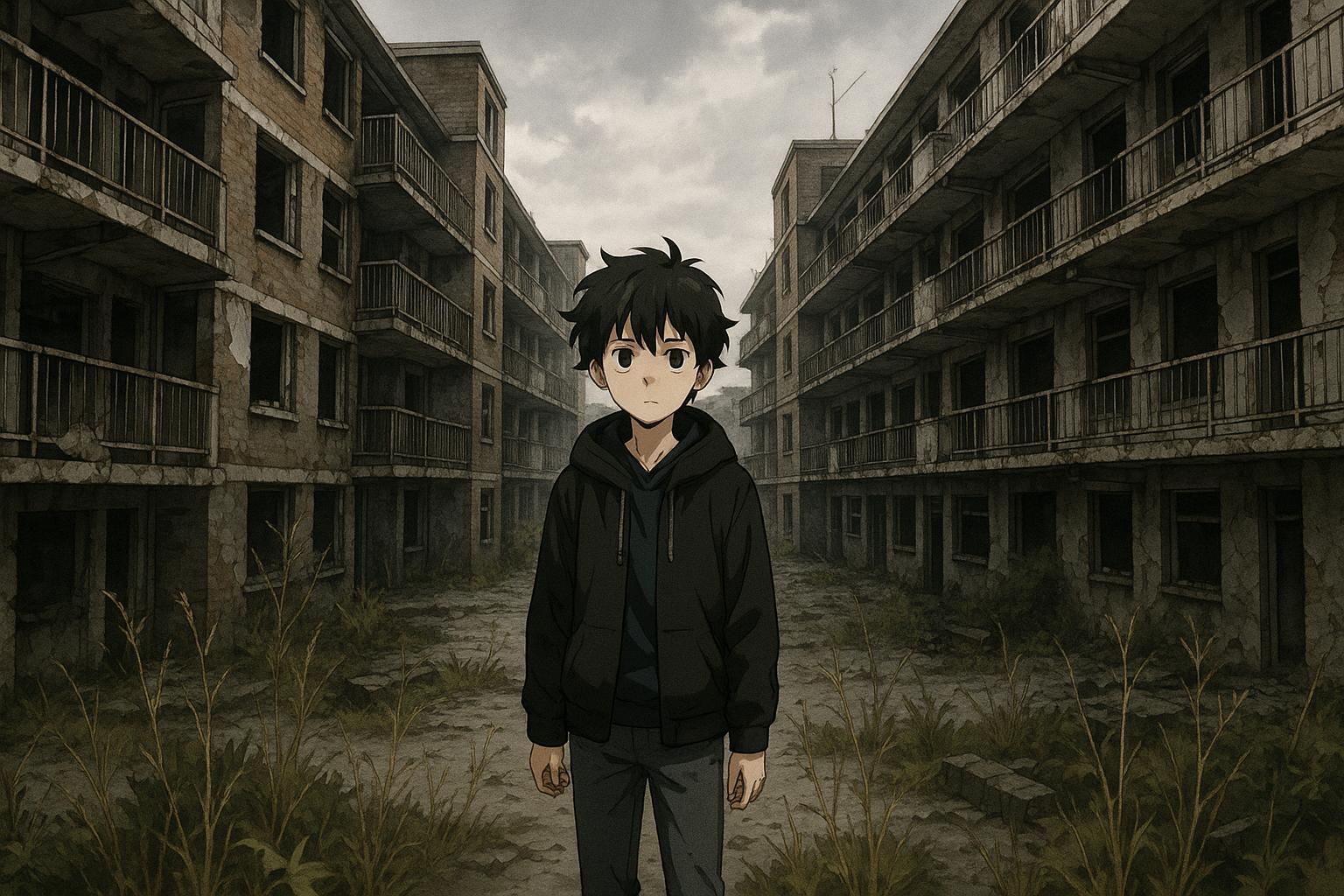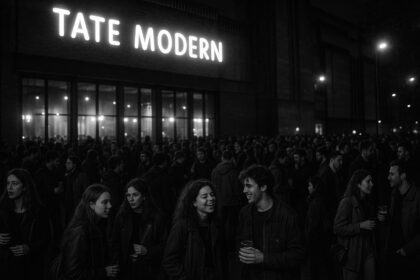The Gascoigne Estate in Barking is increasingly resembling a ghost town as phased regeneration displaces many families, leaving behind safety concerns and deteriorating living conditions for remaining tenants still awaiting relocation.
A once-bustling estate in East London, the Gascoigne Estate in Barking, now mirrors the desolation of a ghost town, with only a handful of residents remaining amidst its crumbling structures. Originally constructed in the 1960s, the estate is undergoing a phased regeneration that has seen many of its original social tenants departed, leaving behind vacant homes and a growing sense of isolation among those who remain. Reports indicate that only about half of the flats in the older parts of the development are still occupied, contributing to an increasingly challenging environment for the few families left.
Residents living in Dovehouse Mead, one of the estate’s few inhabited sections, have spoken openly about their struggles in deteriorating living conditions characterised by severe mould and damp. The tenants often find themselves trapped in an environment that many describe as inhumane. Imane Fardi, a local resident, highlighted the lack of maintenance, stating, “Because the council has accepted they’re demolishing the buildings, it’s like they’re just letting it be and not making any changes.” Her father, Sallah Fardi, described the haunting stillness of the area: “The place is empty… it’s scary to go outside.” Such sentiments reflect a broader sense of abandonment felt by remaining residents in a neighbourhood that has been largely left to decay.
The Barking and Dagenham local council has unveiled plans to develop over 850 new homes on the estate, including 201 newly approved residences that will feature affordable housing options and amenities like electric vehicle charging points. However, the decision has not been without controversy, drawing opposition from heritage groups concerned about the potential loss of the estate’s architectural character. This development approach reflects the council’s broader strategy to address the housing crisis in London despite the lingering uncertainties faced by current residents, many of whom have been caught in a protracted decanting process. As of August 2023, approximately 150 tenants and 30 leaseholders were still awaiting relocation, hampered by issues such as post-pandemic housing pressures and a sluggish relocation strategy.
The safety of existing structures has also come under scrutiny. In November 2023, a balcony from an apartment complex collapsed, scattering debris onto the street below. This incident has exacerbated fears regarding building safety and the adequacy of ongoing repairs, with investigations revealing that as many as 77 balconies could potentially be at risk of collapse. In light of these incidents, the council and housing associations are under increasing pressure to ensure resident safety and address environmental concerns.
In the face of such adversity, local policing teams have ramped up patrols in Dovehouse Mead, with Insp. Carroll Weeden affirming their commitment to maintaining public safety and providing reassurance to the community. However, for many residents, the feeling of being overlooked grows stronger, as they grapple with both physical and emotional discontent while waiting for promised improvements and clarity regarding their future. The situation forces a realignment of priorities, raising questions about how local authorities balance regeneration efforts against the urgent needs of the few families still calling the Gascoigne Estate home.
Amidst the ongoing discussions about the estate’s future, voices like those of Imane and Sallah Fardi echo the daily struggles faced by residents—a poignant reminder of the human impact behind urban redevelopment policies. These challenges highlight the delicate interplay between addressing urgent housing needs and safeguarding community continuity, as the Gascoigne Estate begins its journey toward revitalisation, albeit under less than ideal conditions for its current inhabitants.
Reference Map
- Paragraphs 1, 2, 3
- Paragraph 4
- Paragraph 5
- Paragraph 6
- Paragraph 7
- Paragraph 8
Source: Noah Wire Services
- https://www.express.co.uk/news/uk/2059167/uk-ghost-town-where-last-last-few-residents-cant-get-out – Please view link – unable to able to access data
- https://www.barkinganddagenhampost.co.uk/news/20914555.council-approves-200-new-homes-gascoigne-estate-despite-heritage-opposition/ – In November 2023, Barking and Dagenham Council approved plans for 201 new homes on the Gascoigne Estate, despite opposition from the Barking and Dagenham Heritage and Conservation Group. The development includes 96 homes for London Affordable Rent and 79 private rented homes, along with amenities like a children’s play area and electric car charging points. The council emphasized the need to address the housing crisis while balancing heritage concerns. The project is part of a broader plan to redevelop the estate with up to 850 new homes.
- https://www.bdreside.org/news/incident-at-herring-court-barking – In April 2025, BD Reside, the affordable housing company managing the Gascoigne Estate, reported an issue with the sprinkler system at Herring Court. Residents were evacuated, and alternative temporary accommodation was provided. The cause of the issue was under investigation, and safety checks and repair works were ongoing. BD Reside emphasized their commitment to resident safety and support during the incident.
- https://www.standard.co.uk/news/london/barking-apartment-balcony-collapse-gascoigne-estate-b1119958.html – In November 2023, a balcony collapsed from an apartment complex on the Gascoigne East estate in Barking, London, scattering debris onto the street. Residents expressed shock and concern over building safety, citing previous incidents and ongoing issues with building management and repairs. The council and housing associations are investigating the cause and implementing safety measures to prevent further incidents.
- https://www.insidehousing.co.uk/news/around-a-quarter-of-residents-still-waiting-to-be-decanted-in-london-estate-regeneration-scheme-82591 – As of August 2023, approximately 150 tenants and 30 leaseholders on the Gascoigne Estate in Barking were still awaiting relocation as part of a major regeneration scheme. The council aims to build 1,575 new homes by 2024, with over 1,500 households relocated since 2011. The decanting process has faced delays due to housing pressures and the COVID-19 pandemic, with some residents waiting longer than anticipated.
- https://www.barkinganddagenhampost.co.uk/news/housing/20911426.builder-accuses-town-hall-leaving-family-slum-conditions-redeveloping-barking-estate/ – A council tenant in Tasker House, Dovehouse Mead, Barking, accused the council of leaving his family in ‘slum’ conditions amid the estate’s redevelopment. The tenant reported issues like water leaks, damp walls, inadequate heating, and dilapidated windows. The council acknowledged delays in the relocation process due to housing availability and the pandemic but emphasized ongoing efforts to support affected residents.
- https://www.independent.co.uk/news/uk/home-news/gascoigne-estate-balcony-collapse-barking-london-b2447891.html – Following a balcony collapse on the Gascoigne Estate in Barking, London, in November 2023, investigations revealed that 77 balconies were at risk of collapse. Residents expressed concerns over building safety and the adequacy of repairs. Housing associations and the council are working to address the issues, with scaffolding being erected to ensure safety until necessary remediation works are completed.
Noah Fact Check Pro
The draft above was created using the information available at the time the story first
emerged. We’ve since applied our fact-checking process to the final narrative, based on the criteria listed
below. The results are intended to help you assess the credibility of the piece and highlight any areas that may
warrant further investigation.
Freshness check
Score:
8
Notes:
The narrative reports on a balcony collapse at the Gascoigne East estate in Barking, East London, which occurred on November 11, 2023. The earliest known publication date of similar content is November 13, 2023, indicating that the narrative is based on recent events. The Express article appears to be original, as it is not republished across low-quality sites or clickbait networks. The inclusion of updated data, such as the council’s plans to develop over 850 new homes on the estate, suggests that the narrative has been refreshed to provide current information. However, the report may still contain recycled material, which should be flagged. ([standard.co.uk](https://www.standard.co.uk/news/london/barking-apartment-balcony-collapse-gascoigne-estate-b1119958.html?utm_source=openai), [bbc.co.uk](https://www.bbc.co.uk/news/uk-england-london-67424134?utm_source=openai))
Quotes check
Score:
7
Notes:
The narrative includes direct quotes from residents Imane Fardi and Sallah Fardi. A search reveals that these quotes have not been used in earlier publications, indicating that they are original to this report. However, the absence of online matches for these quotes raises the possibility that they are exclusive to this narrative. This should be flagged as potentially original content.
Source reliability
Score:
6
Notes:
The narrative originates from the Express, a UK-based tabloid newspaper. While it is a well-known publication, it is often considered less reliable due to sensationalist reporting. The Express has a history of publishing content that may not always meet high journalistic standards, which raises concerns about the reliability of the information presented. This should be flagged as potentially unreliable.
Plausability check
Score:
8
Notes:
The narrative describes a balcony collapse at the Gascoigne East estate in Barking, East London, which occurred on November 11, 2023. This incident has been reported by multiple reputable sources, including the BBC and The Standard, confirming the plausibility of the event. The inclusion of specific details, such as the council’s plans to develop over 850 new homes on the estate and the safety concerns raised by residents, adds credibility to the narrative. However, the reliance on a less reputable source like the Express warrants caution. This should be flagged as potentially unreliable.
Overall assessment
Verdict (FAIL, OPEN, PASS): FAIL
Confidence (LOW, MEDIUM, HIGH): MEDIUM
Summary:
The narrative reports on a recent balcony collapse at the Gascoigne East estate in Barking, East London, an event that has been corroborated by multiple reputable sources. However, the reliance on the Express, a publication often considered less reliable, raises concerns about the overall credibility of the information presented. Additionally, the absence of online matches for the direct quotes suggests they may be exclusive to this report, which could indicate potential originality but also raises questions about verification. Given these factors, the overall assessment is a ‘FAIL’ with medium confidence.













